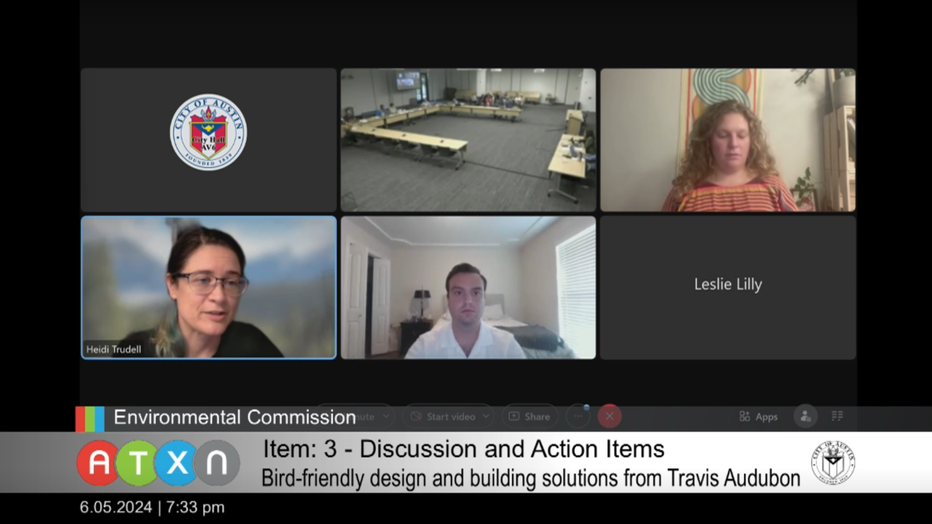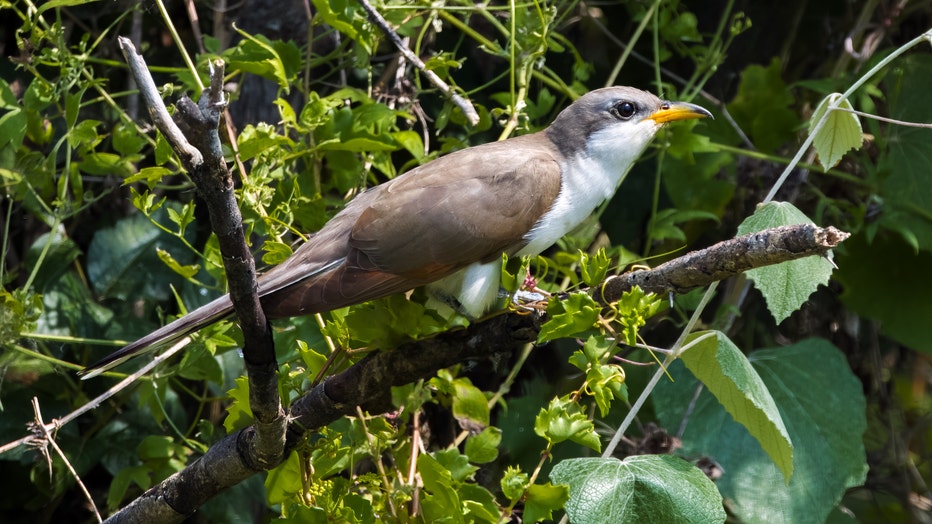Bird-friendly buildings: Austin looking at improving designs, codes

Austin looking into bird-safe building codes
Austin is seen as an environmentally-friendly city, but the building code doesn't necessarily reflect that when it comes to the safety of birds. FOX 7 Austin's Emma Bowen intern Kevin Vu has the story about how Austin is working on changing that.
AUSTIN, Texas - Birding is a popular hobby for many Texans.
In Central Texas, you can spot birds exclusively seen in this region of Texas, such as the Carolina Chickadee and the endangered Golden-cheeked Warbler. However, many bird enthusiasts are concerned over future bird populations' safety, and it’s not just from predators, but buildings.
Texas is home to three of the top ten deadliest cities for birds — Houston, Dallas and San Antonio — according to a 2019 Cornell study.
While Austin was designated a "Bird City" in 2023 by Texas Parks and Wildlife and Audubon Texas for the city’s bird-friendly initiatives, Austin has not implemented any bird-friendly building design codes.

Common Yellowthroat. Photo by Jason Garcia.
For the local bird conservation group Travis Audubon Society, they believe it’s important to have these designs, as Austin is at the heart of the North American Central Flyway — the migration pathway for hundreds of species of birds passing through Texas, Kansas, Colorado, Wyoming and Montana — especially since nearly one billion birds collide with glass in the United States every year.
"Since we are located in the Central Flyway where there are so many birds traveling through while they migrate, it’s important that we adopt more bird-friendly practices and friendly building designs," said Caley Zuzula, program manager for the Travis Audubon Society. "So, when they do come into the city, they aren’t so likely to become victims to a building collision or some other sort of urban threat."
How does glass impact birds?
Heidi Trudell, a consultant and researcher on preventing bird collisions, said, unlike humans who can tell what glass is, for birds, glass is entirely invisible. As glass is a dynamic material that can reflect a bird's environment, birds are unable to see the glass, causing them to collide with the glass.
"To them, they’re either seeing reflections of habitat — it can be anything from a tree, a shrub, a chunk of grass — basically anything that a bird can interact with or that might offer shelter or food, can be an attractant to them," Trudell said. "If they’re seeing a reflection of it, or they’re seeing it through glass that’s transparent, they have no context for seeing the glass and don't comprehend that a physical barrier exists."

Heidi Trudell spoke during a June 5 Environmental Commission meeting to talk about bird-friendly building designs.
Trudell, who also spoke during an Environmental Commission’s meeting in June, said when birds collide with glass, especially at top speeds, the consequences vary. Some birds instantly die from colliding with glass. However, those who survive end up sustaining injuries such as blunt force trauma, brain hemorrhaging, collarbone injuries and even concussions.
"Essentially, a bird colliding with glass is the equivalent of an athlete without a helmet going 30 miles an hour into a brick wall face first," Trudell said. "Even when it is a mild concussion, anytime a bird is on the ground, it's vulnerable. So, the longer it’s stunned, the more likely it is to be grabbed by a cat, a dog, a fox, raccoon, like even deer (and squirrels) will eat birds on the ground."

A yellow-billed Cuckoo, often seen in Texas. Photo by Jason Garcia.
Trudell also noted the height of buildings plays a role in bird collisions. She said people have a misconception that skyscrapers and high-rise buildings cause bird collisions, when low-rise buildings for commercial or campuses cause 56% of bird collisions, residential buildings cause 44% and less than 1% of high-rise buildings cause bird collisions.
"Most birds are active pretty much wherever their food is," Trudell said. "So, while there are a lot of birds active above the treeline, the main threat of bird collisions occurs within the first 100 feet of the ground, depending on where your mature tree canopy is."
What are bird-friendly building designs?
To prevent further bird collisions, the Travis Audubon Society is advocating for the city of Austin to implement bird-friendly building design policies. Bird-friendly building designs are created to be visible to birds. Trudell said this can involve different approaches — from small patterns such as dots etched into glass to using different glass materials such as UV-patterned glass, opaque and translucent glass and even angling glass differently — all of which warn birds before they collide.
"The point is to communicate to the bird that you can’t fit through here," said Maura Powers, a board director for the Travis Audubon Society. "(The patterns) have to be pretty narrow and there has to be an endpoint."

Block 185 or The Sailboat Building is currently occupied by Google. A spokesperson for Pelli Clarke & Partners, the architecture practice who worked on the building, said the building has low glass reflectivity and frit to prevent bird strikes. P
Trudell said there are many examples of bird-friendly buildings across the world. The University of Alabama at Birmingham’s genomics building has small dot patterns etched into the glass two inches apart making a DNA pattern, the Statue of Liberty Museum in New York City and even Block 185 in Austin, currently occupied by Google.
"Given its location adjacent to a creek and urban watershed, as well as its 35-story glass structure, Block 185 had the potential to pose a major risk to local bird populations, including the vulnerable Green Heron and Great Egret," said a spokesperson for Pelli Clarke & Partners, the architecture practice behind Block 185. "The glazing contains elements that prevent bird strikes while remaining invisible to the naked eye, showing how bird friendly glasses present an eco-friendly way to preserve the bird population without compromising a project’s design or the views it’s intended to offer its occupants."
What’s being done?
While Austin is a designated "Bird City" for implementing bird-friendly initiatives such as the Lights Out Resolution and the World Migratory Bird Day Resolution, the Travis Audubon Society said there’s much more work to do. In a June meeting, Austin’s Environmental Commission voted to form a working group to review policies used in different cities and how Austin’s buildings can be bird friendly.
"I do want to echo that as a birder and someone who actually takes people out professionally and guides bird trips, I am seeing less species," said Jennifer Bristol, a commissioner for Austin’s Environmental Commission. "And it’s noticeable every time we go out. It’s sobering, it’s definitely sobering. Whereas you might have used to see hundreds of them, maybe (now)you see 10 or 12 in a season. So it is real, it’s happening right before our very eyes, and we can do something about it."
The working group will consist of people such as commissioners Jennifer Bristol, Peter Einhorn, Mariana Krueger and Dave Sullivan. While representatives from the Austin’s American Institute of Architects chapter, the Travis Audubon Society, the Design Commission and the Animal Advisory Commission will be asked to join the working group.

A Bank Swallow. Photo by James Giroux.
Examples of current building codes with bird-friendly building designs in mind include San Francisco and New York City. New York City requires all new buildings to use more than 90% bird-friendly materials in the first 75 feet of the building, while San Francisco requires all new buildings, additions and significant renovations to have more than 90% of the glass in the first 60 feet to be bird-friendly.
Travis Audubon Society and Trudell said costs to replace or even install bird-friendly glass doesn’t have to be expensive, especially if designers think of bird-friendly designs early on.
While Austin’s Environmental Commission said they expect to have a plan by next April, the Travis Audubon Society said not only do they hope the city of Austin will adopt bird-friendly building codes to help the bird population in Austin, but also investigate how lighting and even landscaping can affect bird populations in urban areas.
"There's no way to overemphasize how dire the situation is for bird populations right now," Trudell said.

